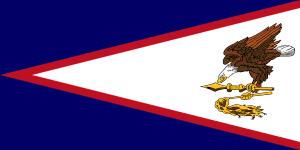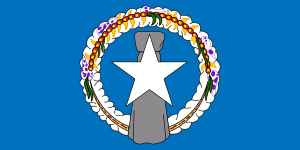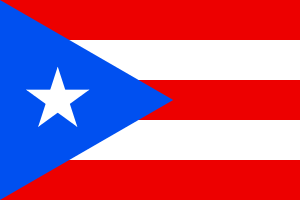Insular area
An insular area is a territory of the United States of America that is neither a part of one of the fifty U.S. states nor the U.S. federal district of Washington, D.C.[1] Such areas are called "insular" from the Latin word insula ("island") because they were once administered by the War Department's Bureau of Insular Affairs, now the Office of Insular Affairs at the Department of the Interior. The term insular possession is also sometimes used.
Congress has extended citizenship rights by birth to all inhabited territories except American Samoa, and these citizens may vote and run for office in any U.S. jurisdiction in which they are residents. The people of American Samoa are U.S. nationals by place of birth, or they are U.S. citizens by parentage, or naturalization after residing in a State for three months.[2] Nationals are free to move around and seek employment within the United States without immigration restrictions but cannot vote or hold office outside of American Samoa.[3]
Residents of insular areas do not pay U.S. federal income taxes but are required to pay other U.S. federal taxes such as import/export taxes,[4][5] federal commodity taxes,[6] social security taxes, etc. Individuals working for the federal government pay federal income taxes while all residents are required to pay federal payroll taxes (Social Security[7] and Medicare).
The U.S. State Department uses the term insular area to refer not only to these territories under the sovereignty of the United States, but also those independent nations that have signed a Compact of Free Association with the United States. While these nations participate in many otherwise domestic programs, they are legally distinct from the United States and their inhabitants are not United States citizens or nationals.
U.S. insular areas can be incorporated territories (i.e., incorporated within all provisions of the U.S. Constitution) or unincorporated territories (areas in which the U.S. Constitution applies partially). From the organization of the Northwest Territory in 1789, all areas not admitted as States were under the direct control of Congress as organized incorporated territories, with some political autonomy at the local level. Since the admission of Hawaii to the Union in 1959, there have been no incorporated territories other than the uninhabited Palmyra Atoll (formerly part of the Hawaii Territory, it was excluded from the act of admission). Several overseas unincorporated territories are now independent countries including the Philippines, the Federated States of Micronesia and the Republic of Palau.
Unlike within the states, sovereignty over insular areas rests not with the local people, but in Congress. In most areas, Congress has granted considerable self-rule through an Organic Act which functions as a local constitution. The Northwest Ordinance grants territories the right to send a non-voting delegate to the U.S. Congress. The United States government is part of several international disputes over the disposition of certain maritime and insular sovereignties some of which would be considered territories. See International territorial disputes of the United States.
List and status of insular areas

Several islands in the Caribbean and the Pacific are considered insular areas of the United States.
Incorporated (integral part of United States)
Inhabited
- none
Uninhabited
-
 Palmyra Atoll (uninhabited, mostly owned by The Nature Conservancy but administered by the Office of Insular Affairs; part of the United States Minor Outlying Islands)
Palmyra Atoll (uninhabited, mostly owned by The Nature Conservancy but administered by the Office of Insular Affairs; part of the United States Minor Outlying Islands)
Unincorporated (United States' possessions)
Inhabited
-
 American Samoa (officially unorganized, although self-governing under authority of the U.S. Department of the Interior)
American Samoa (officially unorganized, although self-governing under authority of the U.S. Department of the Interior) -
 Guam (organized under Organic Act of 1950)
Guam (organized under Organic Act of 1950) -
 Northern Mariana Islands (commonwealth, organized under 1977 Covenant)
Northern Mariana Islands (commonwealth, organized under 1977 Covenant) -
 Puerto Rico (commonwealth, organized under Puerto Rican Federal Relations Act)[8]note 1
Puerto Rico (commonwealth, organized under Puerto Rican Federal Relations Act)[8]note 1 -
 United States Virgin Islands (organized under Revised Organic Act of 1954)
United States Virgin Islands (organized under Revised Organic Act of 1954)
Uninhabited
Along with Palmyra Atoll, these form the United States Minor Outlying Islands:
-
 Baker Island
Baker Island -
 Howland Island
Howland Island -
 Jarvis Island
Jarvis Island -
 Johnston Atoll
Johnston Atoll -
 Kingman Reef
Kingman Reef -
 Midway Atoll (administered as a National Wildlife Refuge)
Midway Atoll (administered as a National Wildlife Refuge) -
 Navassa Island (disputed with Haiti)
Navassa Island (disputed with Haiti) -
 Wake Island (disputed with Marshall Islands)
Wake Island (disputed with Marshall Islands) - Serranilla Bank (disputed with Colombia, Jamaica and Nicaragua)
- Bajo Nuevo Bank (disputed with Colombia, Honduras and Jamaica)
Freely associated states
From July 18, 1947 until October 1, 1994, the U.S. administered the Trust Territory of the Pacific Islands, a United Nations Trust Territory. Later the U.S. entered into new political relationships with each of the four political units. One is the Northern Mariana Islands listed above. The others being the three freely associated states below. The freely associated states are the three sovereign states with a Compact of Free Association with the United States where the U.S. provides national defense, funding, and access to social services.
Former territories
 Philippines, granted to U.S. through the Treaty of Paris in 1898, independence recognized on July 4, 1946.
Philippines, granted to U.S. through the Treaty of Paris in 1898, independence recognized on July 4, 1946. Panama Canal Zone, under effective joint Panama-U.S. control under provisions of the Hay–Bunau-Varilla Treaty from 1903 to 1979.
Panama Canal Zone, under effective joint Panama-U.S. control under provisions of the Hay–Bunau-Varilla Treaty from 1903 to 1979.
See also
- Commonwealth (United States insular area)
- Dependent territory
- Guano Islands Act
- Guantanamo Bay
- Insular Cases
- Political divisions of the United States
- Territorial acquisitions of the United States
- Territories of the United States
- Territories of the United States on stamps
- Unorganized territory
Notes
1. In November 2008 a district court judge ruled that a sequence of prior Congressional actions had had the cumulative effect of changing Puerto Rico's status to incorporated.[9] However, as of April 2011 the issue had not yet made its way through the courts,[10] and as of January 2013 the U.S. government still referred to Puerto Rico as unincorporated.[11]
References
- ↑ "Definitions of Insular Area Political Organizations". Office of Insular Affairs. U.S. Department of the Interior. 2007-01-11. Retrieved 2008-11-09.
- ↑ PBS Newshour, "American Samoans don't have right to U.S. citizenship", Associated Press, June 5, 2015, viewed August 13, 2015.
- ↑ US Department of Interior. "Insular Area Summary for American Samoa". viewed August 13, 2015.
- ↑ "Puerto Ricans pay import/export taxes". Stanford.wellsphere.com. Retrieved August 14, 2010.
- ↑ U.S. State Dept., Foreign Relations of the United States, retrieved 2016-05-18,
The people of Puerto Rico will continue to be exempt from Federal income taxes on the income they derive from sources within Puerto Rico, and into their treasury, for appropriation and expenditure as their legislature may decide, will be deposited the proceeds of United States internal revenue taxes collected on articles produced in Puerto Rico and the proceeds of United States tariffs and customs collected on foreign merchandise entering Puerto Rico.
- ↑ "Puerto Ricans pay federal commodity taxes". Stanford.wellsphere.com. Retrieved 2011-10-30.
- ↑ "Internal Revenue Service. ',Topic 903 – Federal Employment Tax in Puerto Rico',". Irs.gov. December 18, 2009. Retrieved August 14, 2010.
- ↑ Puerto Rican Federal Relations Act, 1950
- ↑ Consejo de Salud Playa Ponce v. Johnny Rullan, p.28: "The Congressional incorporation of Puerto Rico throughout the past century has extended the entire Constitution to the island ...."
- ↑ Hon. Gustavo A. Gelpi, "The Insular Cases: A Comparative Historical Study of Puerto Rico, Hawai'i, and the Philippines", The Federal Lawyer, March/April 2011. http://www.aspira.org/files/legal_opinion_on_pr_insular_cases.pdf p. 25: "In light of the [Supreme Court] ruling in Boumediene, in the future the Supreme Court will be called upon to reexamine the Insular Cases doctrine as applied to Puerto Rico and other US territories."
- ↑ accessed 26 January 2013: "Puerto Rico is a self-governing, unincorporated territory of the United States located in the Caribbean".
External links
| Wikimedia Commons has media related to Insular areas of the United States. |
- Office of Insular Affairs
- Department of the Interior Definitions of Insular Area Political Types
- Rubin, Richard, "The Lost Islands", The Atlantic Monthly, February 2001
- Chapter 7: Puerto Rico and the Outlying Areas, U.S. Census Bureau, Geographic Areas Reference Manual
Coordinates: 18°15′N 66°30′W / 18.250°N 66.500°W